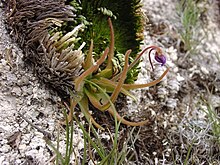Pinguicula gypsicola
| Pinguicula gypsicola | |
|---|---|

| |
| In situ with Selaginella | |
| Scientific classification | |
| Kingdom: | Plantae |
| Clade: | Tracheophytes |
| Clade: | Angiosperms |
| Clade: | Eudicots |
| Clade: | Asterids |
| Order: | Lamiales |
| Family: | Lentibulariaceae |
| Genus: | Pinguicula |
| Species: | P. gypsicola
|
| Binomial name | |
| Pinguicula gypsicola Brandegee (1911)
| |

| |
| Species distribution | |
Pinguicula gypsicola is an
soils and forms stemless rosettes of upright, narrow leaves.Morphology
Pinguicula gypsicola is a perennial
herb. It is heterophyllous, bearing upright, narrow carnivorous leaves with backward bending margins in the summer, and a tight rosette of small, hairy, non-carnivorous leaves in the winter. As is typical for Pinguicula, the carnivorous leaves are densely covered with stalked mucilaginous and sessile digestive glands, which serve to trap and digest insect
prey and absorb the resulting nutrient mixture to supplement their nitrate-low environment. The carnivorous leaves of this species are bright green to reddish and grow up to 6.5 cm. long.
The 2 cm flowers are purple and are born singly on 9 cm inflorescences. They bloom when the start of summer rains triggers summer growth in June or July.
Distribution and habitat
Pinguicula gypsicola is known only from a few areas near its type location west of the city of
Cactaceae, Agave stricta, A. striata, Selaginella cuspidata, Dasylirion longissimum, Dodonaea viscosa and Hechtia glomerata.[1]
Botanical history
Pinguicula gypsicola was first described in 1911 by Townshend Stith Brandegee (1843-1925), a botanist from California.
References
- ^ Casper SJ (1966). Monographie der Gattung Pinguicula L. (Heft 127/128, Vol 31). Stuttgart: Bibliotheca Botanica.
